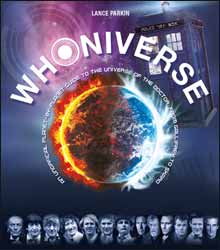|
Click here to return to the main site. Book Review
The most comprehensive unofficial study of the Doctor Who universe ever compiled! What exactly is Trenzalore? Where did the Sontarans originate? Where was the Thousand Day War fought? Where did the Doctor first meet the Quarks? This book answers all those questions and plenty more, helping you discover many exquisite details about the travels of your favourite Time Lord in all of his glorious regenerations. Whoniverse is your own personal ride in the TARDIS, taking you planet-spotting in all the weird and wonderful galaxies that the good Doctor has travelled to and through. This is one adventure that no true Doctor Who fan should miss…! Just as the Time Lords sought to impose order upon a chaotic and divided universe, so Lance Parkin (creator and co-author of Ahistory: An Unauthorised History of the Doctor Who Universe) has made it his job to make sense of the complexities of the Whoniverse. During its long existence, scores of different writers have contributed to Doctor Who, and sometimes these disparate accounts don’t quite tie up – giving us, for example, apparently contradictory explanations for the cause of the Big Bang and the origin of Saturn’s rings. Parkin addresses such matters, taking into account not only the BBC-produced episodes of Doctor Who, Torchwood and The Sarah Jane Adventures (which are inconsistent enough in themselves), but also professional spin-off publications such as comic strips (including sweet cigarette cards), short stories, original novels (including the Faction Paradox books) and audio plays (including the Kaldor City series). Footnotes cite the sources of his information, with icons identifying in which medium the story or episode was first presented (a television set for small screen adventures, a speech balloon for comic strips, an open book for printed prose, and headphones for audio). This 288-page tome is organised into chapters, beginning with The Universe, which describes the Doctor Who cosmos on its grandest scale, including discussions of neighbouring universes and of our own galaxy. Here the author navigates such complexities as the anti-matter universe (combining information from real physics and the television stories The Three Doctors and Planet of Evil) and the different names by which our home galaxy has been known. The Solar System tackles such knotty problems as the number of planets in our star system (which has, at various points in its history, included the worlds of Vulcan, Mondas, the Fifth Planet and Cassius) and the creation of a new moon in Kill the Moon (which, by inference, made its first appearance in 1967’s The Moonbase). This is followed by Earth’s Colonies in Space. Planets of Origin details the worlds of notable alien races. This chapter is subdivided into four sections: Time Lord Planets, Dalek Planets, Cyberman Planets (which cover the three most important extra-terrestrial species in Doctor Who) and Planets of the Monsters (which covers the rest). Here Parkin rationalises which galaxy the Daleks come from (accounts have varied over the years) and how Mondas was for a time known as Marinus (as documented in the Doctor Who Magazine comic strip The World Shapers). The history of Gallifrey after the War in Heaven (from the Eighth Doctor novels by BBC Books) is conspicuously absent from the Time Lord Planets section. However, the Time War is covered under Dalek Planets, since the Daleks were the other combatants in that conflict, and elsewhere in the book. Planets of the Monsters is the largest section of the book, at 82 pages. These pages, together with Earth’s Colonies in Space, were probably the easiest for the author to get his head around, since the planets in question (such as Dido, Solos, Logopolis and Zolfa-Thura) are quite often restricted to just one or a few stories. There are still questions for Parkin to resolve, though, such as the various life forms that have originated from Arcturus and the name of the Sontarans’ home world. Distant Planets looks farther afield to regions such as Andromeda and Galaxy Four, and the book concludes, appropriately enough, with the end of the universe in The Last Planets. Unusually for an unofficial publication, this volume is richly illustrated with artwork and photographs. Owing to the unauthorised nature of the book, many of these pictures are from non-BBC sources, such as newspaper archives, private collections, design drawings, book covers, comic strips, lots of Adrian Salmon illustrations from Doctor Who Magazine, the Dalek movies, and even waxworks. A few of them are printed at a larger size than they really ought to be, resulting in some noticeably low-resolution images – in particular on pages 11, 28–9, 33, 47 and 112–13. Dotted throughout the book are full-page timelines detailing key events about the peoples and places under discussion. These pages have a standard design, boasting an attractive ‘TARDIS in a time spiral’ motif. The problem I have with these timelines is that the events are presented in broadcast or publication order, rather than according to the chronology of the Whoniverse, which I think would have been more useful. Audio adventures from Big Finish’s Lost Stories range are dated according to when the original television production would have been made, rather than the release of the audio version. Aside from my issues with the timelines and the occasional blown-up image, Whoniverse is well laid-out and well thought-out, providing an enjoyable trip through the worlds of Doctor Who, from Axos to Zanak. 8 Richard McGinlay Buy this item online
|
|---|


